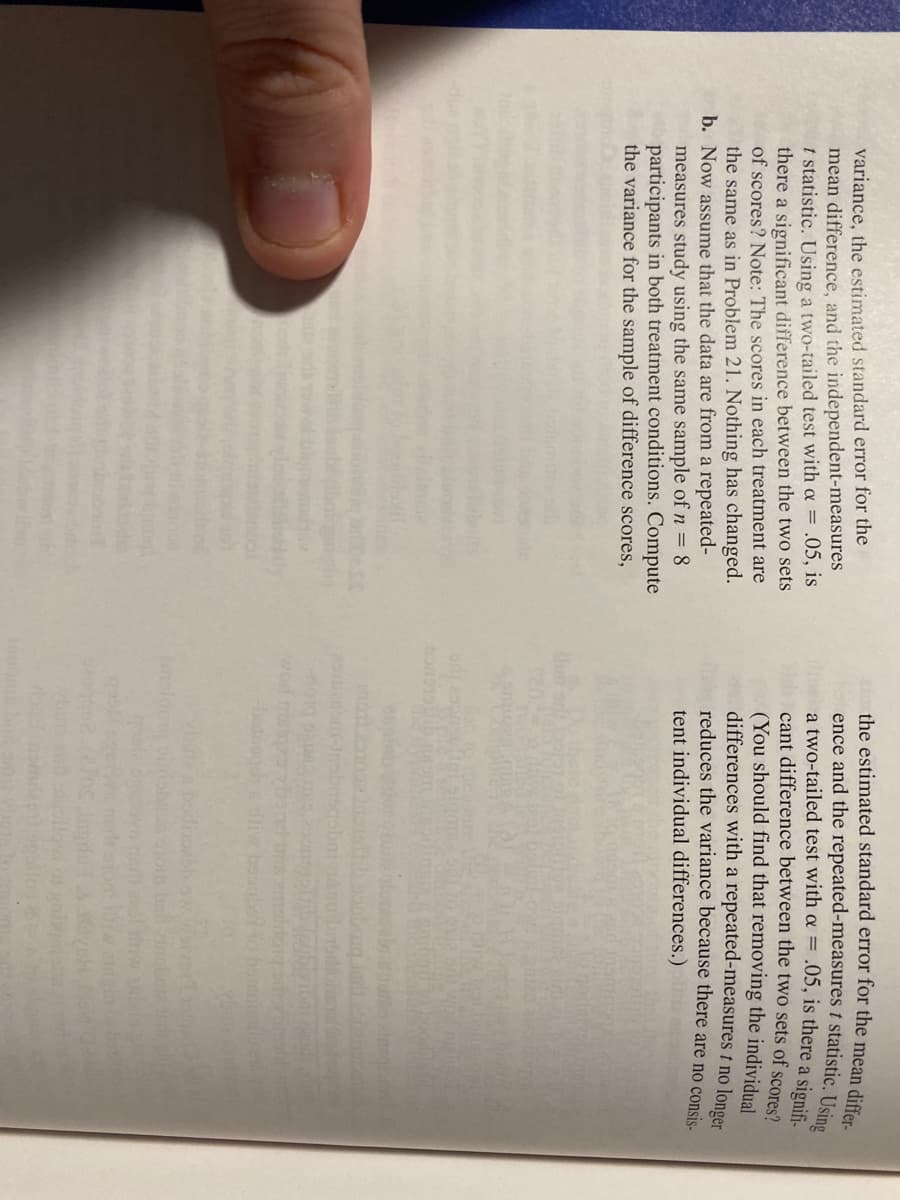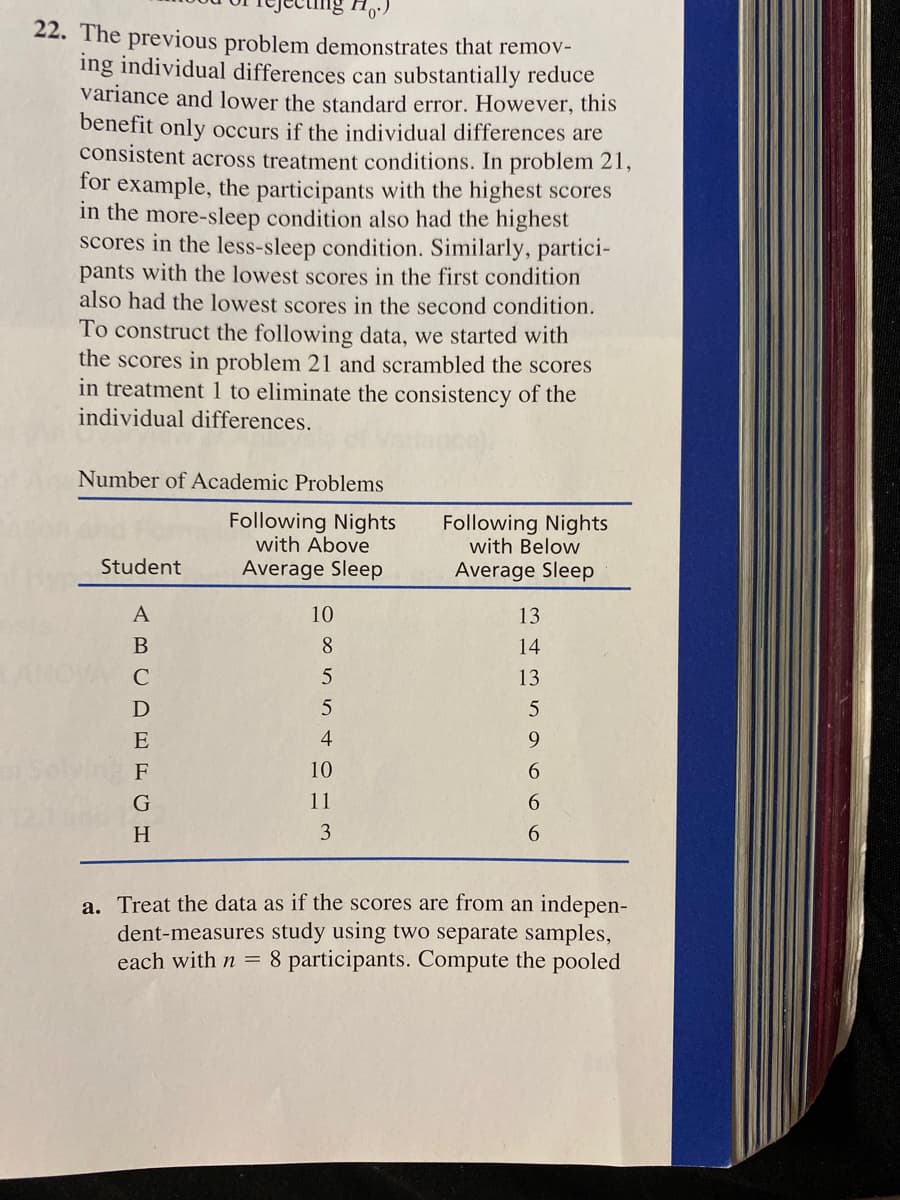22. The previous problem demonstrates that remov- ing individual differences can substantially reduce variance and lower the standard error. However, this benefit only occurs if the individual differences are consistent across treatment conditions. In problem 21, for example, the participants with the highest scores in the more-sleep condition also had the highest scores in the less-sleep condition. Similarly, partici- pants with the lowest scores in the first condition also had the lowest scores in the second condition. To construct the following data, we started with the scores in problem 21 and scrambled the scores in treatment 1 to eliminate the consistency of the individual differences. Number of Academic Problems Following Nights with Above Average Sleep Following Nights with Below Student Average Sleep A 10 13 8 14 13 4 9. F 10 6. 11 6. H 3 6. a. Treat the data as if the scores are from an indepen- dent-measures study using two separate samples, each with n = 8 participants. Compute the pooled
22. The previous problem demonstrates that remov- ing individual differences can substantially reduce variance and lower the standard error. However, this benefit only occurs if the individual differences are consistent across treatment conditions. In problem 21, for example, the participants with the highest scores in the more-sleep condition also had the highest scores in the less-sleep condition. Similarly, partici- pants with the lowest scores in the first condition also had the lowest scores in the second condition. To construct the following data, we started with the scores in problem 21 and scrambled the scores in treatment 1 to eliminate the consistency of the individual differences. Number of Academic Problems Following Nights with Above Average Sleep Following Nights with Below Student Average Sleep A 10 13 8 14 13 4 9. F 10 6. 11 6. H 3 6. a. Treat the data as if the scores are from an indepen- dent-measures study using two separate samples, each with n = 8 participants. Compute the pooled
MATLAB: An Introduction with Applications
6th Edition
ISBN:9781119256830
Author:Amos Gilat
Publisher:Amos Gilat
Chapter1: Starting With Matlab
Section: Chapter Questions
Problem 1P
Related questions
Question

Transcribed Image Text:variance, the estimated standard error for the
mean difference, and the independent-measures
t statistic. Using a two-tailed test with a = .05, is
there a significant difference between the two sets
of scores? Note: The scores in each treatment are
the same as in Problem 21. Nothing has changed.
b. Now assume that the data are from a repeated-
measures study using the same sample ofn = 8
participants in both treatment conditions. Compute
the variance for the sample of difference scores,
the estimated standard error for the mean differ
ence and the repeated-measures t statistic. Usina
a two-tailed test with a = .05, is there a signifi.
cant difference between the two sets of scores?
(You should find that removing the individual
differences with a repeated-measures f no longer
reduces the variance because there are no consis.
tent individual differences.)
anp-
wod miqe
bodhosbow

Transcribed Image Text:22. The previous problem demonstrates that remov-
ing individual differences can substantially reduce
variance and lower the standard error. However, this
benefit only occurs if the individual differences are
consistent across treatment conditions. In problem 21,
for example, the participants with the highest scores
in the more-sleep condition also had the highest
scores in the less-sleep condition. Similarly, partici-
pants with the lowest scores in the first condition
also had the lowest scores in the second condition.
To construct the following data, we started with
the scores in problem 21 and scrambled the scores
in treatment 1 to eliminate the consistency of the
individual differences.
Number of Academic Problems
Following Nights
with Above
Following Nights
with Below
Student
Average Sleep
Average Sleep
10
13
8
14
ANG
5
13
5
4
10
11
3
a. Treat the data as if the scores are from an indepen-
dent-measures study using two separate samples,
each with n = 8 participants. Compute the pooled
666
ABCDEFGH
Expert Solution
This question has been solved!
Explore an expertly crafted, step-by-step solution for a thorough understanding of key concepts.
This is a popular solution!
Trending now
This is a popular solution!
Step by step
Solved in 4 steps

Knowledge Booster
Learn more about
Need a deep-dive on the concept behind this application? Look no further. Learn more about this topic, statistics and related others by exploring similar questions and additional content below.Recommended textbooks for you

MATLAB: An Introduction with Applications
Statistics
ISBN:
9781119256830
Author:
Amos Gilat
Publisher:
John Wiley & Sons Inc

Probability and Statistics for Engineering and th…
Statistics
ISBN:
9781305251809
Author:
Jay L. Devore
Publisher:
Cengage Learning

Statistics for The Behavioral Sciences (MindTap C…
Statistics
ISBN:
9781305504912
Author:
Frederick J Gravetter, Larry B. Wallnau
Publisher:
Cengage Learning

MATLAB: An Introduction with Applications
Statistics
ISBN:
9781119256830
Author:
Amos Gilat
Publisher:
John Wiley & Sons Inc

Probability and Statistics for Engineering and th…
Statistics
ISBN:
9781305251809
Author:
Jay L. Devore
Publisher:
Cengage Learning

Statistics for The Behavioral Sciences (MindTap C…
Statistics
ISBN:
9781305504912
Author:
Frederick J Gravetter, Larry B. Wallnau
Publisher:
Cengage Learning

Elementary Statistics: Picturing the World (7th E…
Statistics
ISBN:
9780134683416
Author:
Ron Larson, Betsy Farber
Publisher:
PEARSON

The Basic Practice of Statistics
Statistics
ISBN:
9781319042578
Author:
David S. Moore, William I. Notz, Michael A. Fligner
Publisher:
W. H. Freeman

Introduction to the Practice of Statistics
Statistics
ISBN:
9781319013387
Author:
David S. Moore, George P. McCabe, Bruce A. Craig
Publisher:
W. H. Freeman